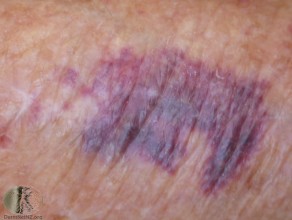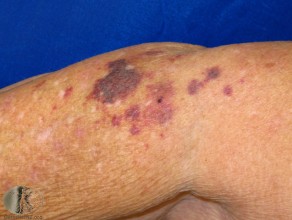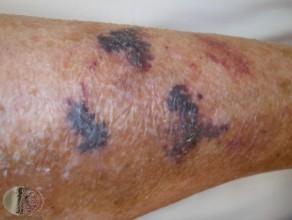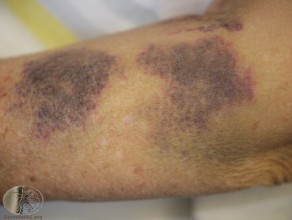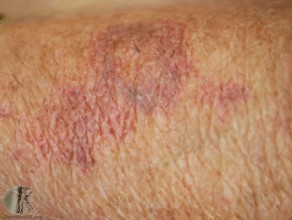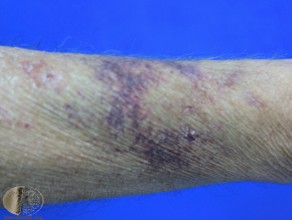What is Senile Purpura?
Page Contents
- 1 What is Senile Purpura?
- 2 Characteristics of Senile Purpura
- 3 Causes of Senile Purpura
- 4 Occurrence
- 5 Symptoms of Senile Purpura
- 6 Diagnosis for Senile Purpura
- 7 Treatment for Senile Purpura
- 8 Complications of Senile Purpura
- 9 When to Visit a Doctor?
- 10 Prevention for Senile Purpura
- 11 Senile Purpura Pictures
Senile Purpura also termed as actinic purpura is a common skin condition that is benign and causes bruises, particularly on forearms and legs. They can also occur in the mucous membranes, especially in the mouth or other internal organs. They are largely common in old people as their skin as well as blood vessels becomes very fragile and thin.
Characteristics of Senile Purpura
In initial stages, they are purplish red and appear as patches or spots on the skin. They may also be called as skin hemorrhages or blood spots. Varying in size, large purpura spots are called ecchymosis while the smaller ones are termed as petechiae.
They do not occur from any deficiency of vitamins or minerals, neither because of any bleeding disorders. Not only severe trauma, but even mild traumas can also lead to the development of these bruises. They are formed when blood leaks under the skin or at the joints of blood vessels.
Causes of Senile Purpura
Some may have the opinion that senile purpura is the effect of vitamin and mineral deficiency, but this is not at all true. The underlying causes are mentioned below:
- Aging
- Too much exposure to the sun
- Overuse of blood-thinning medicines like steroids & aspirin
- Vascular disorders
- Diabetes
- High blood sugar levels
- Thrombocytopenia (deficiency of platelets)
- Blood clotting diseases
- Inflammation of blood vessels
- Changes in pressure during childbirth
- Haemangioma
- Amyloidosis
- Medicines affecting platelet functions
- Meningococcemia
- Infection in brain & spinal cord
- Blood infections
- Bacterial reactions
- Rheumatoid arthritis
- Lupus
- Various drugs like corticosteroids
- Minor trauma
- Connective tissue diseases
- Scurvy
Occurrence
The disorder of senile purpura occurs mostly in older people. About 10% of the people over the age of 50 years get affected by this. This percentage rises with age as More the age; more the people will be prone to this skin disorder.
Symptoms of Senile Purpura
Common senile purpura symptoms appear such as:
- Thinning of skin
- Skin tears very easily
- Large purplish red bruises
- Irregularly shaped lesions from 1-4 cm
- Dark colored lesions on hands, forearm, face & neck
- Adjacent skin inelastic and thin
- Bruises disappearing in three weeks
- Brown or yellow discoloration on fading
- Bruises occur with or without trauma
- Unchanged bruise color till disappearing
- Occurrence in chronic relapsing conditions
- Brown patches remain permanent on skin
Diagnosis for Senile Purpura
It is really important to diagnose senile purpura. The doctor studies all symptoms and medical history of the patient and also undergoes a physical test. He would carry out a thorough examination of the patient. Some tests needed to diagnose the condition are:
- Capillary fragility test
- Bean arm test
- Skin atrophy
- Platelet examination
- Hemostasis tests
- CBC (complete blood count test)
- PT, PTT with INR (a coagulation profile)
- Urine test
- Liver function test
- ESR or CRP test
- Renal function tests
- Skin and blood culture test
- Rheumatoid factor test
Differential diagnosis of Senile Purpura
Again diagnosis may be carried out in different ways for different types of senile purpura. The two types are:
- Palpable purpura
- Non-palpable purpura
Palpable purpura diagnostic measures include detection of:
- Rheumatoid arthritis
- Systemic lupus erythematosus
- Sjogren’s syndrome
- Malignant Lymphoma
- Multiple myeloma
- Leukemia
- Vasculitic injury in liver, kidneys, brain, lungs or gastrointestinal tract
- Blood abnormalities & any infection
- Check if nay intake of reacting drug
- Polyarteritis nodosa
- Henoch-Schonlein syndrome
- Granulomatous vasculitis
- Detect if infusion of drugs like heparin, warfarin, NSAIDs & aspirin,
Non-Palpable purpura diagnostic measures include detection of:
- Dissemination of intravascular coagulation
- Thrombocytopenic purpura
- Thrombocytopenia by drug induction
- Idiopathic thrombocytopenic purpura
- Bacteremia
- Viral infected diseases
- Scurvy
- Chronic statis
- Trauma
- Torch infection
- Systemic disorders
- Anticoagulation therapy
- Actinic variation in body
Diagnostic tests for both these types include:
Conditions for Diagnosis
- Typical in elderly (male and female) more than 60 years of age
- Regular platelet count
- Skin purpura of 1-4 cm diameter mainly on hands, legs, face, neck & underarms
- Positive beam arm test
- Skin atrophy of the affected area
- Normal hemostasis
Treatment for Senile Purpura
The disorder is considered harmless and fades away with time. However, people may not like these patches or bruises on their skin so many seek treatment, which may include:
- Supplementation with vitamin C
- Intake of flavonoids and antioxidants
- Retinoid for further prevention
- Wearing guards on limbs for protection of trauma or injury
- Citrus bioflavonoids twice a day
- Use of tretinoin
- Laser therapy
- Application of topical vitamin K after laser therapy to minimize bruising
Complications of Senile Purpura
Senile purpura does not have any serious complications as it is a benign condition. Only the lesions erupted on the skin may be emotionally distressful and irritating to the patients because it creates a cosmetic disfigurement of the skin.
When to Visit a Doctor?
Senile purpura although harmless, if left untreated may be recurring in occurrence. Using sun blocks and other protective measures can prevent further damage to the skin.
Mostly, purpuric eruptions may last from a week and can extend up to three weeks or so. However, the discoloration might be permanent even after the lesions fade away causing a brown patch in the affected area. One should immediately consult a dermatologist to reduce their appearance.
Prevention for Senile Purpura
- Lifelong usage of sun protection
- Avoid exposure to the sunrays
- Avoid getting out in the sun during 10 am to 3 pm
- If outdoors, wear covering clothes for protection
- Apply sunscreen lotions to the exposed parts of the body

